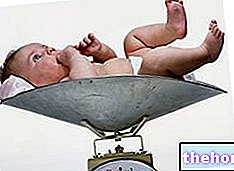NOTES OF EMBRYOLOGY
Embryology studies the sequence of forms of development from the zygote to the organism endowed with all its organs and systems.
In this regard, it is worth remembering the distinction between development (succession of structural and organizational phases with increasing complexity) and growth, intended above all in a quantitative sense.
In vertebrate metazoans we witness, rising in the evolutionary series up to man (through cyclostomes, fish, amphibians, reptiles, birds and mammals), the appearance of adult forms of increasing complexity, for which the complication of the stages of embryonic development.
At the beginning, the zygote, always equipped with reserve material, is divided (by subsequent mitosis) into 2, then 4, then 8, etc. cells called blastomeres, without growth, until it reaches the normal nucleus / cytoplasmic ratio of the species .
This initial segmentation can follow different patterns, depending on the quantity and distribution of the deutoplasm.
At the beginning, the deutoplasm is scarce ("oligolecytic eggs"), so the segmentation is total and gives rise to very different blastomeres. As the complexity of the embryo increases, it takes more time and material before its development allows it to begin. independent life. This requires an increase in deutoplasma ("telolecytic eggs"), which tends to be arranged in a part of the zygote. This causes an increasing "anisotropy", which is linked to modifications of the segmentation, governed by two general principles:
- Hertwig's law says that, in mitosis, the achromatic spindle (whose equator determines the division plane of the daughter cells) tends to be arranged in the direction of greater length of the cytoplasm;
- Balfour's law says that the segmentation speed is inversely proportional to the amount of deutoplasma.
We see then that already in cyclostomes and in fish the segmentation is unequal, with a rapidly segmented animal pole (which will give the upper structures of the embryo) and a yolk pole which will contain most of the reserve material. This tendency is even greater. anisotropic in amphibians (in which it is necessary to prepare the organs responsible for air respiration), in which the yolk pole, while segmenting slowly, remains relatively inert and ends up being covered by cells derived from the rapidly segmenting animal pole. succession of the main embryonic stages includes: zygote, blastomeres, morula (cluster of blastomeres similar to a blackberry), blastula (morula with regressed internal cells), gastrula (blastula in which the cells of one side have become invaginated), in which the primitive cavity of the organism, with an external cellular layer (ectoderm, from which the nervous system will derive first of all) and an int erno (entoderm), between which a third layer (mesoderm) will then interpose. From these layers or "embryonic sheets" will then derive, in an ordered sequence, all the tissues, organs and systems.
In even more evolved species, the increase in deutoplasm (or "calf") is such that it cannot even be segmented. We thus see that in birds the segmentation affects only a thin superficial disc, leading to a "discoblastula" and a series of phenomena that guarantee the formation of the embryo in a different way from the one mentioned above.
A further increase in deutoplasm would probably not have been more efficient, so in Mammals the development and growth up to the capacity of independent life are obtained with another system. We note in fact in Mammals that deutoplasm is used only for the very first stages of development; then the embryo establishes metabolic relationships with the maternal organism (with the appearance of the placenta) and no longer uses the deutoplasm, the excess of which is eliminated. At this point the eggs return to being oligolecitic and the segmentation can go back to being total ( and therefore in the early stages it is similar to that of the "amphioxus), but after the morula the embryogenesis continues according to the most evolved pattern of birds, with a" blastocyst "followed by implantation on the uterine wall, so that the metabolism of the embryo is secured by the maternal organism (via the placenta) rather than by the deutoplasm.
EMBRYO DIFFERENTIATION
When the segmentation of the zygote has brought the nucleus / cytoplasmic ratio to the norm of the species, growth must also begin, parallel to the development. For this reason the metabolism begins, with the appearance of nucleoli and protein synthesis. The protein synthesis thus initiated is due to the genes responsible for the early stages of embryonic development. These genes are depressed by the substances present in the different blastomeres of the animal and calf pole. In turn, the products of these early genes can derepress the operons of the genes in charge of the later stages. The products of this second series of genes will be able to act both in the sense of constructing new embryonic structures and in the sense of repressing the previous operons and derepressing the following ones, in an ordered sequence that leads to the construction of the new organism, thanks to the genetic information accumulated. from the genome through the millennia into ever more evolved species.
Haeckel's famous expression "" ontogeny summarizes phylogeny "actually expresses precisely the fact that the higher species repeat, in the stages of embryonic development, the succession already found in the evolutionarily preceding species.
The early stages of the embryo tend to be similar in vertebrates, particularly up to the appearance of the gills.
In species that pass to air respiration, the gills are then reabsorbed and reused (for example for the formation of endocrine glands), but the genetic information relating to the formation of the gills is also preserved in humans. This is obviously an example of embryonic structural genes which are present in the genome of all vertebrates and must remain repressed after having functioned in their ontogenetic moment.
The interpretation of embryogenesis in the sense of regulation of gene action makes it possible to unify the complex traditional experiences of experimental embryology.
TWINS
The zygote and the first blastomeres, until protein synthesis begins, are totipotent, that is, capable of giving life to an entire organism. To this are connected the experiments of Spemann, who obtained two embryos from the strangulation of an amphibian zygote. A similar phenomenon appears at the basis of the phenomenon of identical twins in man, which precisely for this reason are called monozygotic (MZ). Spemann's experimental twins were half the size of normal, while in man they are perfectly normal. This is explained because in the amphibians the two embryos had to share the only yolk already received, while in the man the embryos can receive, through the placenta, all that is necessary for their development and growth.
It should be remembered that in "man two thirds of the cases of twins have" another origin: they derive from the occasional simultaneous maturation of two follicles, with the release of two ovules which, when fertilized, give two zygotes; in fact, in this case we speak of dizygotic twins (DZ).
Since the MZ twins, divided by mitosis from the single zygote, have the same genome, the differences between them must be of environmental origin. Instead the genome of two DZ twins is similar only as much as that of any two brothers. twin method, widely used in human genetics and also in the field of sport.
In the "man, in which certain ethical reasons would prohibit experimentation, it is possible to ascertain how much any character is regulated by hereditary factors: in fact, strictly inherited characteristics (such as blood groups) are always concordant only in MZ twins; that the concordance of a trait in MZ is close to that of DZ, it is deduced that environmental factors prevail over hereditary ones in determining that phenotypic trait.









.jpg)


















